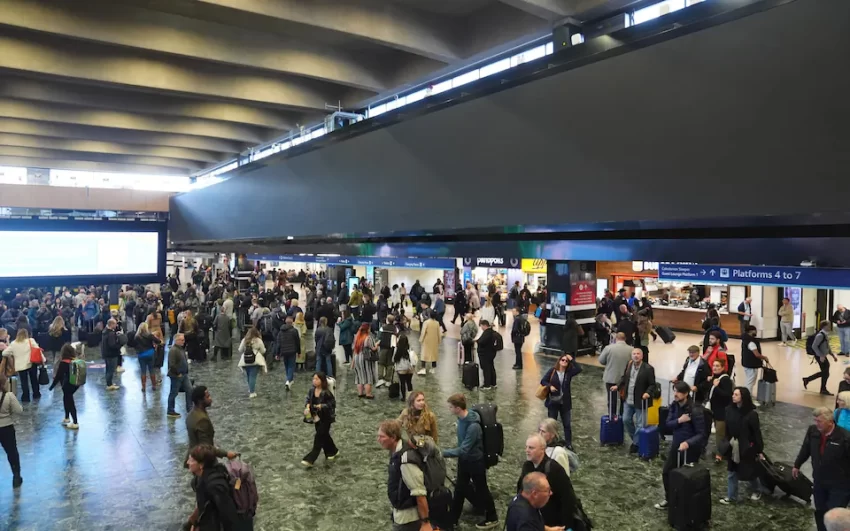Euston station has turned off its 200ft advertising billboard following commuter uproar. Many travellers were left in the dark as crucial passenger information vanished from view.
Amid overcrowded concourses due to mass train cancellations, authorities were compelled to replace adverts with vital travel updates, sparking debate.
Commuter Chaos at Euston
The decision to switch off the colossal advertising billboard at Euston station comes after severe disruptions on Avanti West Coast trains. Commuters were left in turmoil when the concourse was overwhelmed with crowds and critical passenger information was missing. Transport Secretary Louise Haigh stepped in, directing Network Rail to turn off the 200ft screen which had dominated the concourse. Advertising for Canadian holidays and movies like Transformers took precedence over essential travel updates, igniting widespread dissatisfaction.
Transport Secretary’s Intervention
In light of these significant disruptions, Louise Haigh remarked that Euston station’s performance was inadequate for passengers. The screen, replacing one of the UK’s largest passenger information boards, was heavily criticised as a ‘terrible decision’. With routes affected from Birmingham to Glasgow, the lack of crucial travel info frustrated many.
In response to this feedback, Network Rail stated that the billboard had been turned off and that a thorough review would assess its impact on station congestion. The critical question is whether the billboard contributes to congestion or possibly aids passenger movement.
Analyzing the Impact
Network Rail plans to employ heat modelling techniques to analyse the effects of the billboard shutdown on passenger flow. This advanced method will offer crucial insights into whether the screen’s absence alters congestion patterns. With the chaotic conditions prevailing, this analysis is pivotal.
Despite the backlash, Network Rail defends its current setup. A spokesperson mentioned that although the bulkhead departure board was popular, it hindered station circulation. The new arrangement aims to enhance movement efficiency, discrediting previous configurations.
The advertising screen’s shutdown is part of a larger five-point strategy aimed at improving passenger experiences at Euston station. Its measures include extending concourse space, better operational procedures during disruptions, and enhanced train service reliability on the West Coast Main Line.
Future Plans for Euston Station
Gary Walsh, the route director for West Coast South, acknowledged that recent passenger experiences at Euston have been subpar. He emphasised the urgent need for improvement, expressing confidence that the five-point plan would lead to significant, short-term benefit.
Integrating the JCDecaux billboard for displaying travel information during disruptions is under discussion. Known as Euston Motion+, this screen was launched in January as part of a campaign for an energy company. This initiative aims to balance advertising needs with essential passenger information.
Public Reaction to Euston’s Changes
The public’s response to the adjustments at Euston has been vocal. Commuters demand that essential travel information be prioritized over advertising content, especially during periods of intense disruption. The decision to switch off the billboard is seen as a necessary step to refocus on passenger needs.
While Network Rail asserts the new configuration benefits passenger movement, many remain sceptical. The debate over Euston’s priorities reflects a broader concern regarding transport infrastructure transparency and efficiency.
Ultimately, the situation at Euston highlights the tenuous balance between commercial interests and public service obligations. As plans unfold, stakeholders continue to advocate for solutions that place passenger welfare at the forefront.
Looking Forward
Network Rail’s strategic decision to disable the Euston billboard is both reactive and proactive. It comes as part of a broader strategy to elevate passenger services while addressing public concerns head-on. The learnings from this situation could inform future infrastructure projects in the UK.
Continued dialogue with JCDecaux and ongoing monitoring will determine long-term strategies for integrating advertising with travel information. The outcome of these discussions will significantly influence the station’s operational dynamics going forward.
Conclusion
Euston’s steps to enhance passenger experience illustrate a critical shift towards prioritizing traveller needs amid infrastructural challenges. Learning from past oversights, the station’s future developments strive for a balanced approach between advertising revenues and essential service provision.
Euston’s steps to enhance passenger experience illustrate a critical shift towards prioritising traveller needs amid infrastructural challenges. Learning from past oversights, the station’s future developments strive for a balanced approach between advertising revenues and essential service provision.

